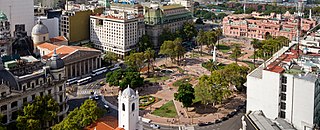
The Plaza de Mayo is a city square and main foundational site of Buenos Aires, Argentina. It was formed in 1884 after the demolition of the Recova building, unifying the city's Plaza Mayor and Plaza de Armas, by that time known as Plaza de la Victoria and Plaza 25 de Mayo, respectively. The city centre of Buenos Aires, Plaza de Mayo has been the scene of the most momentous events in Argentine history, as well as the largest popular demonstrations in the country. On the occasion of the first anniversary of the May Revolution in 1811, the Pirámide de Mayo was inaugurated in the square's hub, becoming Buenos Aires' first national monument.

The Buenos Aires Underground, locally known as Subte, is a rapid transit system that serves the area of the city of Buenos Aires, Argentina. The first section of this network opened in 1913, making it the 13th subway in the world and the first underground railway in Latin America, the Southern Hemisphere, and the Spanish-speaking world, with the Madrid Metro opening five years later, in 1919. Currently, Buenos Aires is the only Argentine city with a metro system.

Line A is the oldest line of the Buenos Aires Underground. Opened to the public on 1 December 1913, the first underground line in South America, the Southern Hemisphere and the Spanish-speaking world. It made Buenos Aires the 13th city in the world to have an underground transport service. The line stretches 9.8 km from Plaza de Mayo and San Pedrito and runs under all of the Avenida de Mayo and part of the Avenida Rivadavia, and is used by 258,000 people per day.
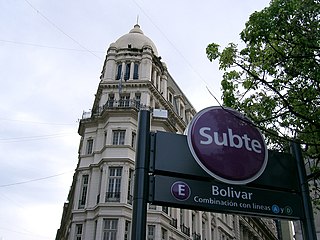
Line E of the Buenos Aires Underground, which runs from Retiro to Plaza de los Virreyes, currently extending a total distance of 12 km. Opened in 1944, the Line E was the last completely new line to be added to the Buenos Aires Underground, until 2007 when Line H was opened. The line has a history of being re-routed and extended due to having been historically the line with the lowest passenger numbers on the network.

Constitución railway station is a large railway station in Constitución, a barrio in central Buenos Aires, Argentina. The full official name of the station is Estación Plaza Constitution reflecting the fact that the station is located opposite Constitution Square, two kilometers to the south of the Obelisco landmark. The ground floor of the station has fourteen tracks and the floor below has two tracks for the Buenos Aires Underground.
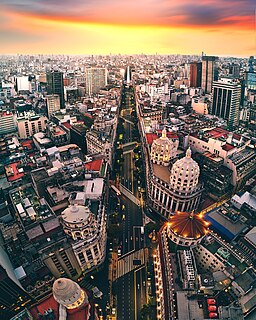
Avenida Roque Sáenz Peña, better known as Diagonal Norte, is an important avenue in the San Nicolás neighborhood of Buenos Aires, Argentina. It is oriented south-east/north-west, diagonally bisecting the city blocks (manzanas) which give the city centre a checkerboard plan. It is named after President Roque Sáenz Peña, who held power from 1910 to 1914 and passed the law which established universal suffrage, secret ballot and an electoral register.

The Urquiza Line is a 26 km (16 mi) suburban electric commuter rail line in Buenos Aires, Argentina, operated by the Buenos Aires Underground operator Metrovías. It runs from the Federico Lacroze terminus in the neighborhood of Chacarita, to General Lemos terminus in Campo de Mayo district of Greater Buenos Aires, completing a total journey time of 46 minutes. The line uses third rail current collection and, at present, is used by an average of 75,400 passengers daily. The line operates 20 hours a day, 7 days a week at 8 to 30 minute intervals. This suburban line runs on track once operated by General Urquiza Railway before railway privatisation.
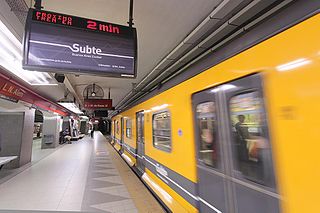
Leandro N. Alem is a terminal station of the Line B of the Buenos Aires Underground. The station's name honours Leandro N. Alem, a UCR politician from the late 19th century.

Plaza Miserere is a station on Line A of the Buenos Aires Underground. The station is located between Alberti and Loria / Pasco stations on the A line underground. Plaza Miserere has interchange with Once underground station of the H line and connection to the Sarmiento line commuter rail service within Once railway station, the central station of the Domingo Faustino Sarmiento Railway.

Plaza de Mayo is a station on Line A of the Buenos Aires Underground. This station belonged to the first section of line opened on 1 December 1913, linking the station with the station of Plaza Miserere.

Catedral is a terminal station of the Line D of the Buenos Aires Underground. From here, passengers may transfer to the Perú station on Line A and the Bolívar station on Line E.

Perú is a station on Line A of the Buenos Aires Underground. Passengers may transfer from here to the Catedral Station on Line D and to the Bolívar Station on Line E.

Alberti is a station on Line A of the Buenos Aires Underground. The station belonged to the inaugural section of the Buenos Aires Underground opened on 1 December 1913, which linked the stations Plaza Miserere and Plaza de Mayo. Like the Pasco station, it is one of two stations of the line which only has one platform, in this case only serving passengers heading towards San Pedrito. The other platform is located just a few meters away, but was closed in 1953 since the proximity of Pasco station meant having so many stops in such quick succession slowed the line's frequency.

Congreso is a station on Line A of the Buenos Aires Underground. It lies at the intersection of Rivadavia and Callao avenues, in the neighborhood of Balvanera. It is located just metres from the Palace of the Argentine National Congress. The station belonged to the inaugural section of the Buenos Aires Underground opened on 1 December 1913, which linked the stations Plaza Miserere and Plaza de Mayo.

Sáenz Peña is a station on Line A of the Buenos Aires Underground. It is the last station of the line located under the Avenida de Mayo in the neighbourhood of Monserrat. The station belonged to the inaugural section of the Buenos Aires Underground opened on 1 December 1913, which linked the stations Plaza Miserere and Plaza de Mayo.

Lima is a station on Line A of the Buenos Aires Underground. Passengers may transfer from here to the Avenida de Mayo station on Line C and Metrobus 9 de Julio. The station belonged to the inaugural section of the Buenos Aires Underground opened on 1 December 1913, which linked the stations Plaza Miserere and Plaza de Mayo.
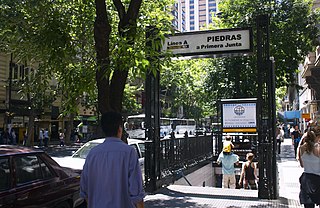
Piedras is a station on Line A of the Buenos Aires Underground. It is located underneath the Avenida de Mayo in the neighbourhood of Monserrat and one of its entrances is located next to the famous Café Tortoni. The station belonged to the inaugural section of the Buenos Aires Underground opened on 1 December 1913, which linked the stations Plaza Miserere and Plaza de Mayo.

Bolívar is a station on Line E of the Buenos Aires Underground at is located on the Diagonal Sur avenue by the Plaza de Mayo. From here, passengers may transfer to the Perú Station on Line A and the Catedral Station on Line D. The station was opened on 24 April 1966 as the eastern terminus of the extension of the line from San José. On 3 June 2019, the line was extended to Retiro.
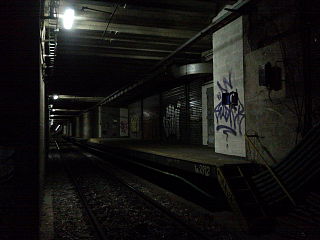
Alberti Norte is a ghost station in the Buenos Aires Underground, which was part of Line A until its closure in 1953. It is one of two ghost stations on the line, the other being Pasco Sur.

Pasco Sur is a ghost station in the Buenos Aires Underground, which was part of Line A until its closure in 1953. It is one of two ghost stations on the line, the other being Alberti Norte.























